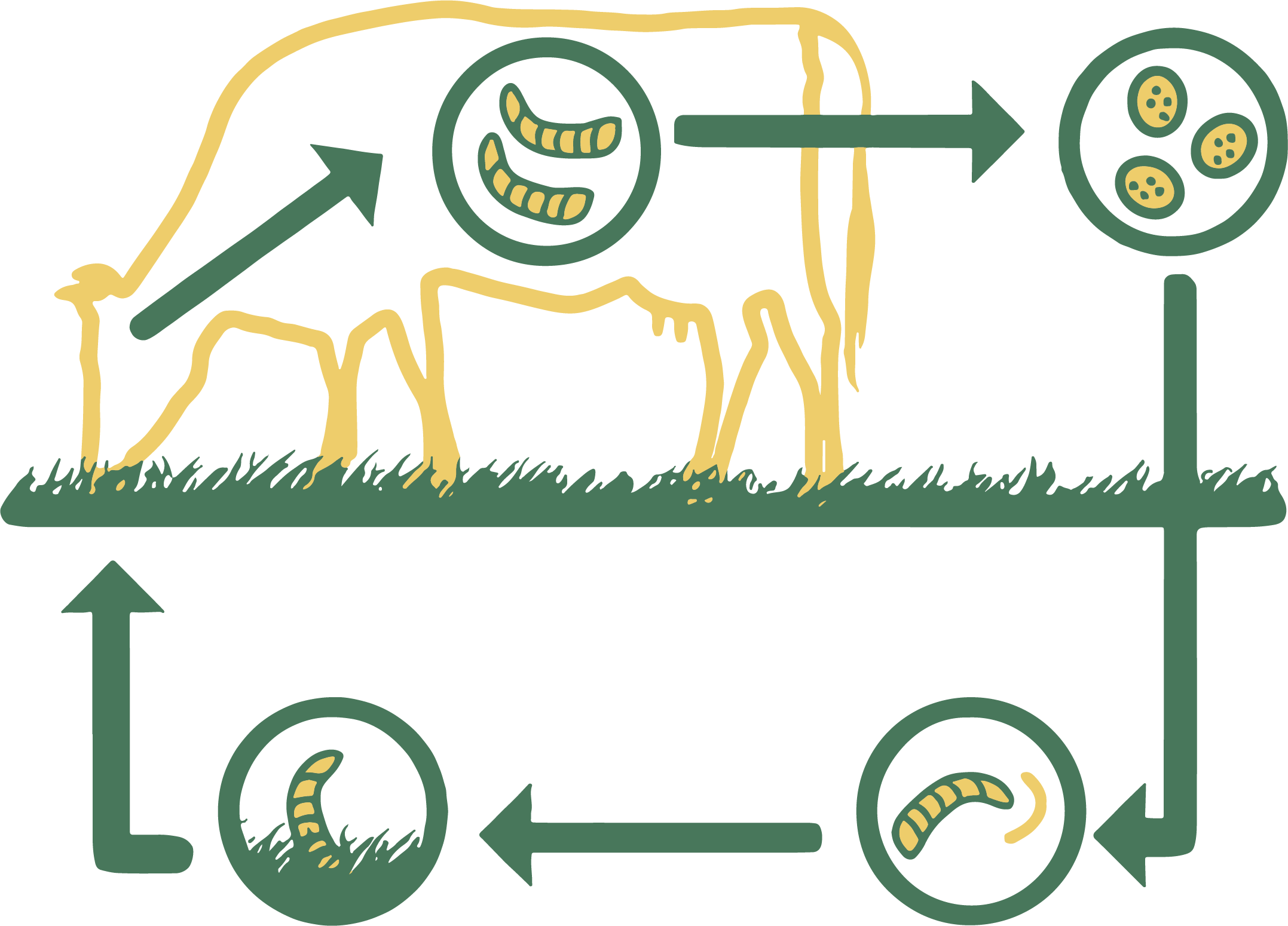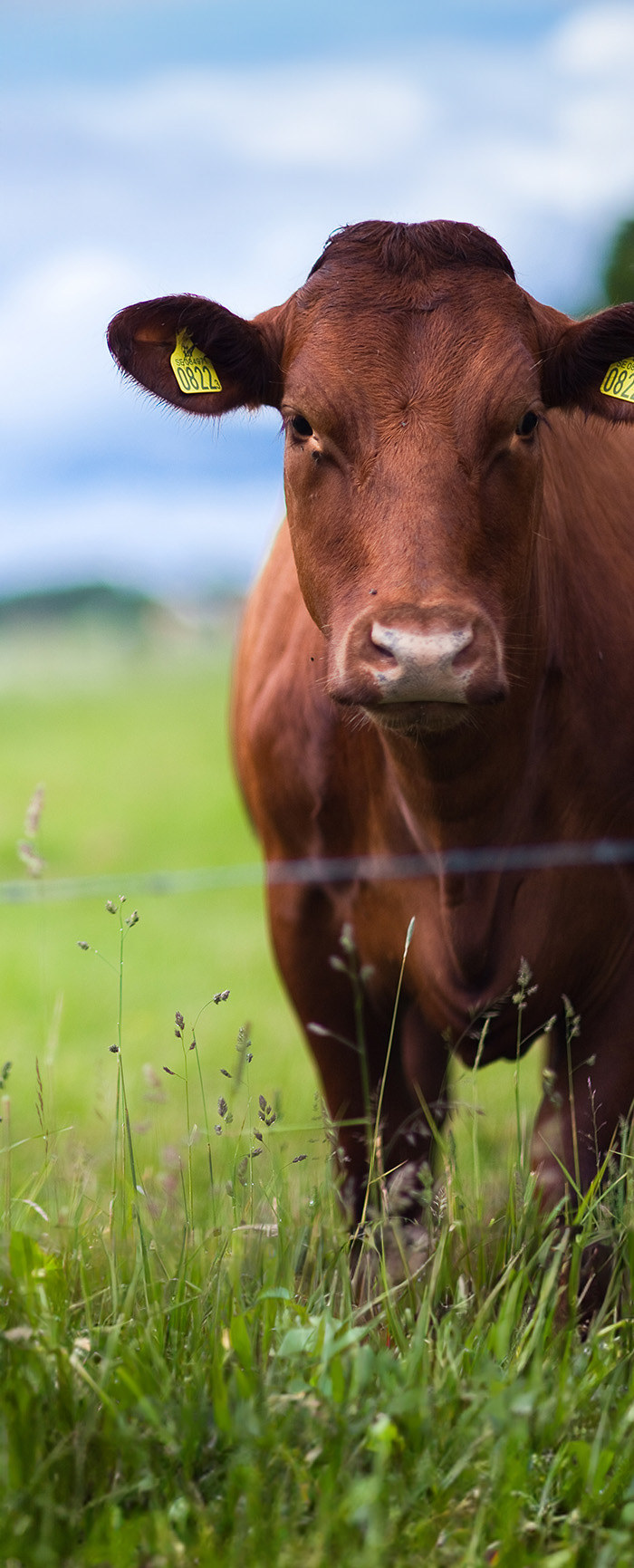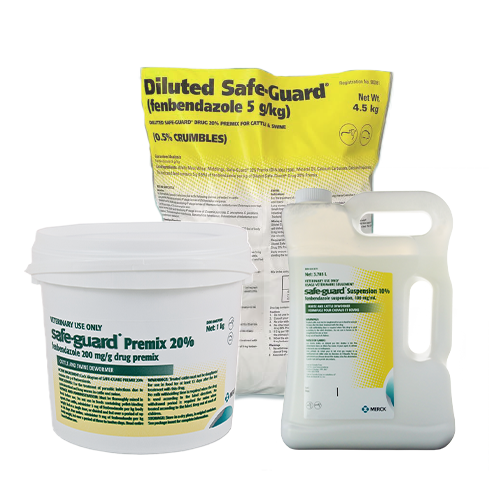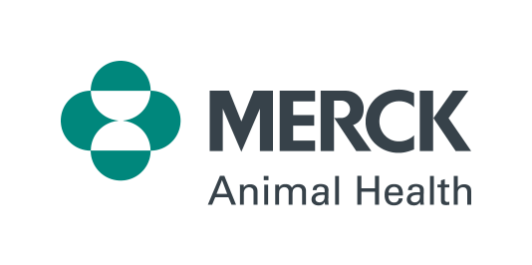
Safeguard your cattle through strategic parasite management
Consult your veterinarian for assistance in the diagnosis, treatment and control of parasitism.
Internal parasite infestations in cattle have been shown to reduce feed intake, weight gain, feed efficiency and animals’ ability to fight disease.1,2,3 This is why it is important to help reduce the worm burden both in animals and on pasture through strategic deworming.
Gastrointestinal nematodes cost North American cattle operations more than $2 billion per year in treatment costs and lost productivity.4
Up to 95% of your farm’s internal parasites can be found on pasture 5, where it is ingested by grazing cattle, perpetuating the cycle.

ONLY 5-10% in host 5


90-95% on pasture 5
PARASITE RESISTANCE:
A serious and costly threat to the cattle industry
Some parasites have since become resistant to certain classes of anthelmintics due to a number of factors, including:
- Intensive use to the exclusion of other management practices.
- Improper product dosing.
- Improper application timing.
Anthelmintic resistance can be very damaging to an operation through:
- production losses, and
- the continued contamination of cattle’s environment, resulting in future infections.6
Fecal egg counts (FECs) and fecal egg count reduction tests (FECRTs) are used to assess the efficacy of your deworming programs.
- FECs are performed before deworming to assess the type of parasites cattle may have, and the number of parasite eggs per 3 grams of feces.
- FECRTs are recommended 14 days after deworming to assess the efficacy of the treatment.
- A greater than 90% reduction in FEC should be achieved after deworming.7
- Efficacy below 90% is suggestive of lack of product efficacy.8


Hit internal parasites where they live with Safe-Guard®
Safe-Guard® is indicated for the treatment of parasitic infections in cattle, due to lung worms, stomach worms and intestinal worms.†
Safe-Guard®:
- Has been demonstrated to achieve fecal egg count reductions above the 90% efficacy threshold guidelines.8
- Goes straight to the gut, delivering its active compound (fenbendazole) right where worms live and reproduce.
- Works to kill worms and control egg shedding, thereby reducing worm burdens in animals and on pasture.
- Helps improve pasture performance of cattle infected with internal parasites.
- In western Canadian studies conducted over three consecutive years, increased weight at weaning was demonstrated in calves treated with Safe-Guard® (18.2 lb9, 26.8 lb10, and 11.6 lb11) compared to non-treated calves.
Always read product labels for more information on administration instructions and warnings.
†Lungworm: Adult and 4th larval stage of Dictyocaulus viviparus. Stomach worms: Adult and 4th larval stages of Haemonchus contortus, Ostertagia ostertagi and the adult stage of Trichostrongylus axei. Intestinal worms: Adult and 4th larval stages of Cooperia punctata, C. oncophora, C. pectinata, C. mcmasteri, Trichostrongylus colubriformis, Nematodirus helvetianus, Bunostomum phlebotomum, and Oesophagostomum radiatum.

Safe-Guard® Calculator Application
Save time. Save money.
And take the guesswork out of deworming!
- Calculator function for dosages, quantities and total costs.
- Price comparison tool for different formulations of fenbendazole
- Contact form to submit questions or concerns.

Effective control of parasites – both internal and external – plays an important role in maintaining the health, welfare and performance of cattle.
- Snider TG, Williams JC, Karns PA, Romaire TL, Trammel HE, and Kearney MT. Immunosuppression of lymphocyte blastogenesis in cattle infected with Ostertagia ostertagi and/or Trichostrongylus axei. Vet. Immunol. Immunopathol. (1986) 11:251–264.
- Wiggin CJ, and Gibbs HC. Adverse immune reactions and the pathogenesis of Ostertagia ostertagi infections in calves. Am. J. Vet. Res. (1990) 51:825–832.
- Gómez-Muñoz MT, Canals-Caballero A, Almeria S, Pasquali P, Zarlenga DS, and Gasbarre LC. Inhibition of bovine T lymphocyte responses by extracts of the stomach worm Ostertagia ostertagi. Vet. Parasitol. (2004) 120:199–214.
- Stromberg BE, Gasbarre LC. Gastrointestinal nematode control programs with an emphasis in cattle. Vet Clin. Food Anim. (2006) 22:543-565.
- Stromberg BE and Averbeck GA. What’s New for Parasite Control in Cattle. Minnesota Dairy Health Conference (1988).
Retrieved from the University of Minnesota Digital Conservancy, http://purl.umn.edu/117341. - Bliss DH, Moore RD, and Kvasnicka WG. Parasite resistance in U.S. cattle. (2008) The AABP Proceedings, Vol. 41: 109-114.
- Dobson R, Jackson F, Levecke B, Besier B, et al. Guidelines for fecal egg count reduction tests (FECRT). World Association for the Advancement of Veterinary Parasitology (WAAVP) (2011) Proceedings: 23rd International Conference of the World Association for the Advancement of Veterinary Parasitology.
- Are dewormers working? A decade of results.An efficacy summary of the Fecal Egg Count Reduction Test (FECRT) National Database (2009-2018), Merck Animal Health.
- Determination of the benefit of a strategic deworming program for cow/calf operations in western Canada. Study AH75-SAFG-M-2012.
- Determination of the benefit of a strategic deworming program for cow/calf operations in western Canada. Study AH85-SAFG-M-2013.
- Determination of the economic benefit of a Strategic Deworming combined with an Anabolic Implant Program for Cow/Calf operations in western Canada.
Study 41-AH90-SGRA-M-2014.
SAFE-GUARD® is a registered trademark of Intervet International B.V., used under license

